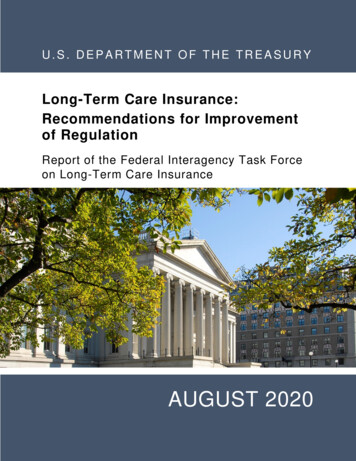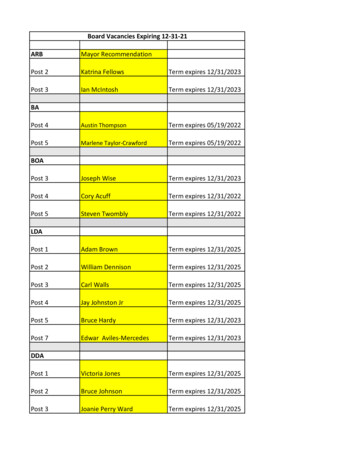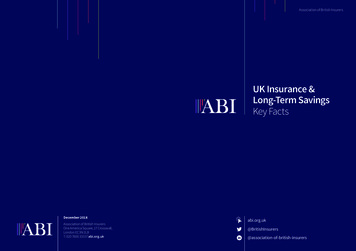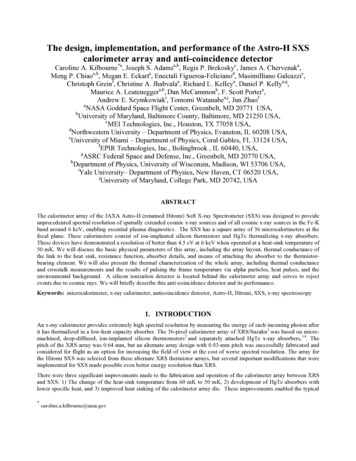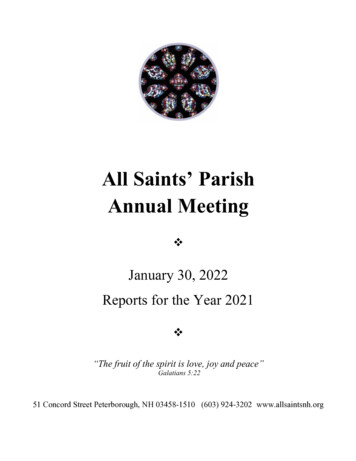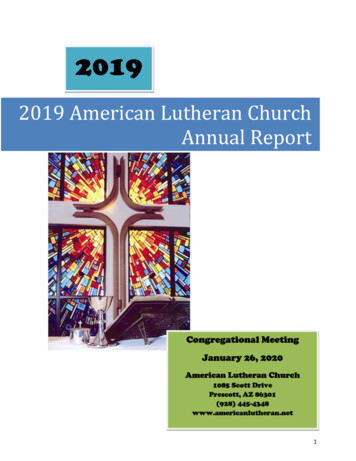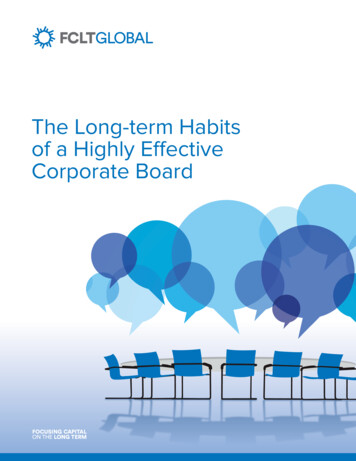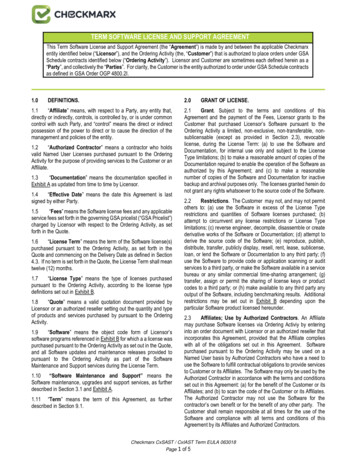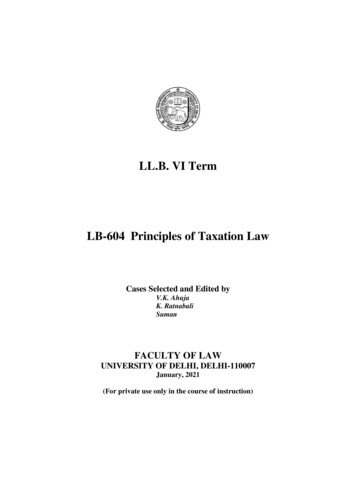
Transcription
LL.B. VI TermLB-604 Principles of Taxation LawCases Selected and Edited byV.K. AhujaK. RatnabaliSumanFACULTY OF LAWUNIVERSITY OF DELHI, DELHI-110007January, 2021(For private use only in the course of instruction)
iiLL.B. VI TermPaper – LB – 604 –Principles of Taxation LawPrescribed Legislation : The Income Tax Act, 1961Prescribed Book :1. Vinod K. Singhania & Kapil Singhania, Taxmann’s Direct Taxes – Law & Practice2. Girish Ahuja & Ravi Gupta, Direct Taxes – Law and PracticeTopic 1: IntroductionConcept of – Tax, Cess, Surcharge; Types of taxes: Direct Taxes, Indirect Taxes; Definitionof Income [Section 2(24)] – Application of Income or diversion by overriding title - CapitalReceipt v. Revenue Receipt - Tests to distinguish (with special reference to ‘Salami’);Assessee; Previous Year (section 3); Assessment year; Basis of charge (Receipt, Accrual, andArisal); General Scheme of Income Tax Act, 19611. CIT v. G.R. Karthikeyan, 1993 Supp (3) SCC 2222. CIT v. Sitaldas Tirathdas (1961) 2 SCR 6343. C.I.T. v. Sunil J. Kinariwala (2003) 1 SCC 6601612Topic-2 : Agricultural Income – Meaning of Agricultural Income[Section 2(1A), 10(1)]4. Bacha F. Guzdar v. C.I.T., Bombay, AIR 1955 SC 745. C.I.T. v. Benoy Kumar Sahas Roy, AIR 1957 SC 7686. Premier Construction Co. Ltd. v. C.I.T., Bombay City(1948) XVI ITR 380 (PC)7. C.I.T. v. Maddi Venkatasubbayya (1951) XX ITR 151 (Mad.)8. Sakarlal Naranlal v. C.I.T., AIR 1965 Guj. 1659. C.I.T. v. H.G. Date (1971) 82 ITR 71 (Bom.)10. K. Lakshmanan & Co. v. C.I.T. (1999) 239 ITR 597 (SC)1721364052Topic-3 : Residence and Scope of Total IncomeTests for the determination of residential status of Assessee (section 6); Total income ofassessee (sections 4 and 5); Income deemed to accrue or arise in India (section 9); Incidenceof tax varies with residential status of an assessee?11. V.V.R.N.M. Subbayya Chettiar v. C.I.T., AIR 1951 SC 10154
iii12. Narottam and Parekh Ltd. v. CIT, Bom. City, AIR 1954 Bom. 6713. Vodafone International Holdings B.V. v. Union of India (UOI)and Anr, (2012)6SCC6135863Topic-4 : Heads of Income (Sections 14-59)Heads of Income (section 14), Rationale; Heads, whether mutually exclusiveHead A : Salaries (Sections 15 to 17) – Chargeability - Meaning of Salary; Perquisites;Profits in lieu of salary13. Ram Pershad v. C.I.T. (1972) 2 SCC 696 : AIR 1973 SC 63714. C.I.T. v. L.W. Russel, AIR 1965 SC 498490[Head B : Omitted by the Finance Act, 1988 with effect from 1-4-1989]Head C : Income from House Property (Sections 22 to 27) - Ingredients of section 22 Annual Value how to be determined - Deductions under section 24 - Deemed owner (section27)15. C.I.T., West Bengal v. Biman Behari Shaw, Shebait(1968) 68 ITR 815 (Cal.)16. East India Housing & Land Development Trust Ltd. v. C.I.T.(1961) 42 ITR 49(SC)17. R.B. Jodhamal Kuthiala v. C.I.T., AIR 1972 SC 1269598100Head D : Profits and Gains of Business and Profession (Sections 28 to 44) –Applicability- Deductions - Bad debts18. B.D. Bharucha v. C.I.T., AIR 1967 SC 150519. C.I.T. v. Mysore Sugar Co. Ltd., AIR 1967 SC 723107110Business Expenditure – Allowability - Tests of distinctions between Business expenditure andCapital expenditure [section 37(1)]20. C.I.T. v. Travancore Sugar & Chemicals Ltd.,AIR 1973 SC 98221. Empire Jute Co. v. C.I.T., AIR 1980 SC 194622. L.B. Sugar Factory & Oil Mills(P.) Ltd. v. C.I.T.,AIR 1981 SC 39523. C.I.T. v. Jalan Trading Co. (Pvt.) Ltd. (1985) 155 ITR 536 (SC)24. BIkaner Gypsums Ltd. v. C.I.T., AIR 1991 SC 22725. C.I.T. v. General Insurance Corporation, 2007 (1) SCJ 800114123128136
ivHead E: Capital Gains (Sections 45 to 55) – Definition of capital assets [section 2(14)];Short term capital assets [section 2(42A)]; Short term capital gains [section 2(42B)]; Longterm capital assets and Long term capital gain [section 2(29A) and 2(29B)]; Meaning of‘Transfer’[section 2(47)]; computation (section 45); Transactions not amounting to transfer(sections 46 and 47); Mode of computation (section 48); Meaning of ‘adjusted’, ‘cost ofimprovement’ and ‘cost of acquisition’(section 55)26. N. Bagavathy Ammal v. C.I.T., Madurai, JT 2003 (1) SC 363141Head F: Income from Other Sources (Sections 56 to 59)27. C.I.T. v. Rajendra Prasad Moody (1978) 115 ITR 519 (SC)145Topic 5 : Income of Other Persons included in Assessee’s Total Income (Sections 60 to64) - concept of clubbing of income – justifiability - throwing of separate property into thecommon stock of Joint Hindu Family and subsequent partition of the same section 64(2)28. Philip John Plasket Thomas v. C.I.T., AIR 1964 SC 58729. Batta Kalyani v. Commissioner of Income Tax(1985) 154 ITR 5930. J.M. Mokashi v. Commissioner of Income Tax(1994) 207 ITR 252 (Bom)31. Mohini Thapar v. C.I.T. (1972) 4 SCC 493148154157166Topic 6 : Assessment - Best Judgment Assessment; Income escaping assessment(Sections 139, 142, 143, 144, 145(2), 147, 148, 149, 150, 151 and 153)32.33.34.35.36.State of Kerala v. C. Velkutty (1966) 60 ITR 239 (SC)C.I.T. v. Burlop Dealers Ltd. (1971) 79 ITR 609 (SC)Gemini Leather Stores v. The Income-tax Officer,AIR 1975 SC 1268The Income Tax Officer v. Lahkmani Mewal Das(1976) 3 SCC 757Srikrishna (P) Ltd. v. Income-Tax Officer (1996) 9 SCC 534167172175177183IMPORTANT NOTE:1. The topics and cases given above are not exhaustive. The teachers teaching the course shallbe at liberty to add new topics/cases.2. The students are required to study the legislations as amended up-to-date and consult thelatest editions of books.
v3. The question paper will include one compulsory question. The question papers set for theexaminations held during 2010-11 and 2011-12 are printed below for guidance of thestudents.*****LL.B. III Term Examinations, December 2010Note:Attempt five questions including Question No. 1 which is compulsory.All questions carry equal marks.1. Attempt briefly any four of the following:(i) Explain ‘Profits in Lieu of Salary’.(ii) Explain the meaning of ‘Deemed owner’ as provided in Section 27.(iii) Write the distinction between capital receipt and revenue receipt.(iv) Explain the mutual exclusivity of heads of income.(v) Explain the meaning of ‘Transfer’ as provided in section 2(47) of the Income TaxAct.2. (i) Discuss the residential status of an individual.(ii) Discuss the residential status of a company which is registered in India but wascontrolled and managed from Singapore during the previous year.3. Define the term ‘agriculture’ with the help of case law. State the conditions required to befulfilled for a process performed on an agricultural produce to be an agricultural process.4. How annual value of a house property is determined? Can there be annual value of ahouse which cannot be used for residence in view of the injunction contained in the willby which the assessee became the owner of the house?5. The assessee spent Rs. 5 crores to make arrangements to show direct broadcast ofCommonwealth Cames on a big screen in his threate. The amount was spent on thepurchase of screen and renovation of theatre to make it fit for this purpose.Discuss the decide, explaining the difference between capital expenditure and businessexpenditure, whether the aforesaid expenditure is business expenditure.6. (i) Discuss the law laid down in N. Bagavathy Ammal V. CIT, Madurai JT 2003 (1) SC363.(ii) Spell out the distinction between section 57(iii) and Section 37(i) of the Income TaxAct in the light of CIT v. Rajendra Prasad Moody (1978) 115 ITR 519 (SC).7. Discuss the statutory provisions can case law relating to clubbing of income of a spouseand minor children with that of assessee.8. Write short notes on any two of the following:(i) Perquisites;(ii) Income;(iii) Distinction between application of income and diversion of income.
viLL.B. III Term (Supplementary) Examinations, June-July 2011Note:Attempt five questions including Question No. 1 which is compulsory.All questions carry equal marks.1. Attempt briefly any four of the following:(i) Scope of total income under section 5 of Income Tax Act, 1961(ii) Difference between capital receipt and revenue receipt.(iii) Deemed Owner as defined under Section 27.(iv) What is the meaning of profits in lieu of salary as provided under section 17(3)?(v) Write some of the transactions which are not regarded as transfer within themeaning of section 47.2. Critically analyse the conditions required to the fulfilled for a process performed on anagricultural produce to be an agricultural process. Support with case laws.3. (i) When is a Director of a Company taxable under the Head “Salary” for theremuneration he got from the company? Discuss in the light of Ram Pershad v. C.I.T.(1972) 2 SCC 696.(ii) Whether the contributions paid by the employer to the assessee under the terms of atrust deed in respect of a contract for a deferred annuity on the life of the assessee is a‘perquisite’ as contemplated by section 17(2) of the Income Tax Act?4. Discuss the residential status of —(i) An Individual(ii) Hindu Undivided Family5. Mr. ‘X’ is a successful lawyer who runs a law firm. His wife work as a receptionist cumAccountant in the law firm and draws a salary of Rs. 10,000 per month from the firm. Theeducational qualification of his wife is class XII pass and currently pursing her B.A.degree though correspondence. While computing the total income of Mr. ‘X’, theAssessing Officer clubbed the salary of his wife too. Discuss whether Mr. ‘X’ willsucceed in avoiding clubbing of his wife’s salary in his total income.6. (a) Discuss Mutual Exclusivity of Heads of Income.(b) How is the annual value of house property determined for the purpose of imposingtax under the head ‘Income from House property’.7. What are the tests of distinctions between Business expenditure and capital expenditure.Discuss in the light of section 37(i). Also discuss the difference between sections 37(i)and section 57(iii).8. Write short notes on any two of the following:(i) Deduction on account of Bad Debt in the light of B.D. Bharucha v. CIT, AIR 1967SC 1505.
vii(ii) Discuss the judgement of Supreme Court in N. Bhagavathy Ammal v. CIT, JJ 2003(1) SC 363.*****LL.B. III Term Examinations, December 2011Note:Attempt any five questions. All questions carry equal marks.1. (a) Define Incomes and analyse the statement “A any receipt which partakes the natureof income is part of the income.”Comment in the light of case law.(b) The assessee, Mr. X is a partner ina firm having 60% of share in profits and losses.He creates a Trust, where beneficiaries are 3 members of his family. He also transfers50% of his share in the firm by way of Deed of Assignment in favour of Trust out oflove and affection. Mr. X claims 50% of income transferred to the trust as Diversionof Income. Decide with the help of cases.2. Define the term “Agriculture”.Discuss whether the following incomes can be treated as Agricultural Income for thepurpose of Income Tax? Give reasons.(i) Dividend paid by the company out of Agricultural Income.(ii) Income from sale of sisal fibre made after processing aloe plants.(iii) Internet on arrears of rent in respect of Agricultural Land.(iv) Income from sale of forest trees.3. (a) A company formed under Companies Act, creates a superannuation fund for thebenefit of its employees, where the premium contribution from the employee andcompany is and rd respectively. Under a clause, the employee can claim to such fundonly after expiry of term of 15 years in the said company. The Assessing Officerincludes such contribution as taxable under the head salaries for the employees.Decide with the help of cases.(b) The assessee, Tea Company, derives its income from sale of tea products. TheDirector of the company had advanced amount Rs. 20,00,000 to his friend Mr. S, whois a film producer @ 9% p.a. for an upcoming film. Due to certain reasons movie isunsuccessful and the amount advanced is irrecoverable from Mr. S, the assesseecompany writes off the amount as bad debts. Decide with the help of cases whetherthe assessee will be successful?4. (a) Mr. Sebastian Vittel, participates in Formulae 1 Race at Budh Circuit, India and earnsby way of endorsements and winnings Rs. 11 crore. The Assessing Officer chargeshis income under Income Tax Act, 1961 but he claims he is not an assessee andneither resident in India. Decide.
viii(b) The Assessee Company Carrying on the business in Ceylon, is a subsidiary companyof ABC Ltd., which is registered Office at Mumbai and meeting of Board of Directorsand shareholders are also held in Mumbai. The affairs of assessee company aremanaged by the two managers, with widest powers and authorities which is conferredupon them by way of Power of Attorney. Decide whether the Assessee Company isResident Company or not?5. How the annual value of House Property is determined? Discus “Deemed Owner” underIncome from House Property. Give relevant case laws.6. The assessee, Modi Sugar Mills Pvt. Ltd. Co. is carrying on with the business of sale ofsugar and factory is situated at Modinagar in U.P. The road was to be constructed toconnect Modinagar with Meerut. Under the development scheme promoted byGovernment and Sugar Factories were to bear the cost of construction of the road. TheAssessee Company contributed Rs. 1,00,000 on request of the Collector. The AssessingOfficer considers the amount as Capital Expenditure. Decide and Illustrate with casedecisions difference between Capital Expenditure and Revenue Expenditure.7. (a) The Assessee is a shareholder in a company. The company goes into liquidation andon account of settlement between the company and shareholders, the companytransfers agricultural land as part of full and final settlement between them. Theassessee claims exemption from tax on agricultural which are entitled to be excludedwhile computing the Capital Gains on assets received from company on liquidation.Decide with the help of cases.(b) Discuss the law laid down in C.I.T. vs. Rajendra Prasad Moody (1978) 115 ITR 519(SC).8. The assessee, Mr. K makes a certain cash gifts to his wife Mrs. M. She invests the part ofthe amount in shares and part in other securities which during a financial year yieldedreturns in form of individuals and interests. The Assessing Officer includes suchindividuals and interests in the assessment of Mr. K to which Mr. K objects.Decide in the light of provisions relating to aggregation of income along with relevantcases.*****LL.B. III Term Examinations, June-July, 2012Note:Attempt any five questions. All questions carry equal marks.1. (i) Define Income and analyse the statement “any receipt which partakes the nature ofIncome is part of the Income under Sec 2(24) of Income Tax Act, 1961.” Comment inthe light of case law.(ii) Distinguish between application of Income and Diversion of Income with the help ofcase law.
ix2. (i) Define the term “Agriculture” and discuss ‘ordinary process employed, to render theproduce fit to be taken to the market” with the help of case law.(ii) Whether the following incomes can be treated as Agricultural Income for the purposeof Income Tax? Discuss with the help of case law.(a) Dividend paid by the company out of Agricultural Income(b) Income from salt produced by flooding of land with sea water.(c) Compensation from insurance company for damaged caused by hailstorm to thecrop.(d) Interest on arrears of rent in respect of agricultural land.3. (i) When remuneration paid to Managing Director of a company becomes chargeable toincome tax under the head “salary”? Discuss with the help of case law.(ii) What are perquisites? State which are taxable and which are exempt from tax underIncome Tax Act, 1961?4. (i) Discuss residential status of Individual.(ii) Discuss giving reasons whether the following transactions will give rise to incomewhich will be deemed to accrue or arise in India.(a) Mr. J, chief executive of a company had undertaken foreign tour on variousoccasion for company work and was out of India for a total number of 225 daysduring the previous year ending 31.03.2010. He seeks advice for filing his returnfor assessment year 2010-11.(b) A foreign company having no Indian citizen/resident of India as share holder hasshot a TV film entirely on Indian locations. The film is to be telecast exclusivelyin foreign countries. But it has also agreed with Government of India to give rightof telecast in India, free of charge.5. How the annual value of House Property is determined and what is the significance ofdeemed owner under Income from House Property?6. Distinguish between “Capital Expenditure” and “Revenue Expenditure” with the help ofcase law.7. (i) Discuss the Basis of charge for capital Gains and exemption provided thereof with thehelp of case decisions.(ii) Mr. ‘X’, has substantial interest in XYZ Ltd. And Mrs. ‘X’ is employed by XYZ Ltd.Without any technical or professional qualification to justify the remuneration.Discuss the charge of income tax under Sec 64(1) in light of case decisions.8. Write short notes on any two with relevant case laws.(i) Bad Debt(ii) Profits in lieu of salary(iii) Distinction between capital receipt and revenue receipt
C.I.T. v. G.R. Karthikeyan1993 Supp (3) SCC 222B.P. JEEVAN REDDY, J. - The question referred under Section 256(1) of the IncomeTax Act reads as follows:Whether, on the facts and in the circumstances of the case, the Appellate Tribunalwas right in holding that the total sum of Rs 22,000 received by the assessee from theIndian Oil Corporation and All India Highway Motor Rally should not be brought totax?2. The assessment year concerned is 1974-75. The assessee, G.R. Karthikeyan, assessedas an individual, was having income from various sources including salary and businessincome. During the accounting year relevant to the said assessment year, he participated in theAll India Highway Motor Rally. He was awarded the first prize of Rs 20,000 by the IndianOil Corporation and another sum of Rs 2000 by the All India Highway Motor Rally. TheRally was organised jointly by the Automobile Association of Eastern India and the IndianOil Corporation and was supported by several Regional Automobile Associations as well asFederation of Indian Motor Sports Clubs and the Federation of Indian AutomobileAssociations. The rally was restricted to private motor cars. The length of the rally route wasapproximately 6956 kms. One could start either from Delhi, Calcutta, Madras or Bombay,proceed anti-clockwise and arrive at the starting point. The rally was designed to testendurance driving and the reliability of the automobiles. One had to drive his vehicleobserving the traffic regulations at different places as also the regulations prescribed by theRally Committee. Prizes were awarded on the basis of overall classification. The method ofascertaining the first prize was based on a system of penalty points for various violations. Thecompetitor with the least penalty points was adjudged the first-prize winner. On the abovebasis, the assessee won the first prize and received a total sum of Rs 22,000. The Income TaxOfficer included the same in the income of the respondent-assessee relying upon thedefinition of ‘income’ in clause (24) of Section 2. On appeal, the Appellate AssistantCommissioner held that inasmuch as the rally was not a race, the amount received cannot betreated as income within the meaning of Section 2(24)(ix). An appeal preferred by theRevenue was dismissed by the Tribunal. The Tribunal recorded the following findings:(a) That the said rally was not a race. It was predominantly a test of skill andendurance as well as of reliability of the vehicle.(b) That the rally was also not a ‘game’ within the meaning of Section 2(24)(ix).(c) That the receipt in question was casual in nature. It was nevertheless not anincome receipt and hence fell outside the provisions of Section 10(3) of the Act.3. At the instance of the Revenue, the question aforementioned was stated for the opinionof the Madras High Court. The High Court held in favour of the assessee on the followingreasoning:(a) The expression ‘winnings’ occurring at the inception of sub-clause (ix) in Section2(24) is distinct and different from the expression ‘winning’. The expression ‘winnings’
2has acquired a connotation of its own. It means money won by gambling or betting. Theexpression ‘winnings’ controls the meaning of several expressions occurring in the subclause. In this view of the matter, the sub-clause cannot take in the receipt concernedherein which was received by the assessee by participating in a race which involved skillin driving the vehicle. The rally was not a race. In other words the said receipt does notrepresent ‘winnings’.(b) A perusal of the memorandum explaining the provisions of the Finance Bill,1972, which inserted the said sub-clause in Section 2(24), also shows that the idea behindthe sub-clause was to rope in windfalls from lotteries, races and card games etc.(c) Section 74(A) which too was introduced by the Finance Act, 1972 supports thesaid view. Section 74(A) provides that any loss resulting from any of the sourcesmentioned therein can be set off against the income received from that source alone. Thesources referred to in the said section are the very same sources mentioned in sub-clause(ix) of Section 2(24) namely lotteries, crossword puzzles, races including horse-races,card-games etc.5. The definition of ‘income’ in Section 2(24) is an inclusive definition. The Parliamenthas been adding to the definition by adding sub-clause(s) from time to time. Sub-clause (ix)which was inserted by the Finance Act, 1972 reads as follows—(ix) any winnings from lotteries, crossword puzzles, races including horse-races,card-games and other games of any sort or from gambling or betting of any form ornature whatsoever.6. We may notice at this stage a provision in Section 10. Section 10 occurs in Chapter IIIwhich carries the heading “Incomes which do not form part of total income”. Section 10insofar as is relevant reads thus:10. Incomes not included in total income.- In computing the total income of aprevious year of any person, any income falling within any of the following clausesshall not be included *****(3) any receipts which are of a casual and non-recurring nature, not beingwinnings from lotteries, to the extent such receipts do not exceed one thousandrupees in the aggregate.7. It is not easy to define income. The definition in the Act is an inclusive one. As said byLord Wright in Kamakshya Narayan Singh v. CIT [(1943) 11 ITR 513 (PC)] “income . is aword difficult and perhaps impossible to define in any precise general formula. It is a word ofthe broadest connotation”. In Gopal Saran Narain Singh v. CIT [(1935) 3 ITR 237 (PC)] thePrivy Council pointed out that “anything that can properly be described as income is taxableunder the Act unless expressly exempted”. This Court had to deal with the ambit of theexpression ‘income’ in Navinchandra Mafatlal v. CIT [AIR 1955 SC 58]. The IndianIncome Tax and Excess Profits Tax (Amendment) Act, 1947 had inserted Section 12(B) in theIndian Income Tax Act, 1922. Section 12(B) imposed a tax on capital gains. The validity ofthe said amendment was questioned on the ground that tax on capital gains is not a tax on‘income’ within the meaning of Entry 54 of List 1, nor is it a tax on the capital value of the
3assets of individuals and companies within the meaning of Entry 55 of List 1 of the SeventhSchedule to the Government of India Act, 1935. The Bombay High Court repelled the attack.The matter was brought to this Court. After rejecting the argument on behalf of the assesseethat the word ‘income’ has acquired, by legislative practice, a restricted meaning - and afteraffirming that the entries in the Seventh Schedule should receive the most liberal construction- the Court observed thus:What, then, is the ordinary, natural and grammatical meaning of the word‘income’? According to the dictionary it means ‘a thing that comes in’. In the UnitedStates of America and in Australia both of which also are English speaking countriesthe word ‘income’ is understood in a wide sense so as to include a capital gain. Ineach of these cases very wide meaning was ascribed to the word ‘income’ as itsnatural meaning. The relevant observations of learned Judges deciding those caseswhich have been quoted in the judgment of Tendolkar, J. quite clearly indicate thatsuch wide meaning was put upon the word ‘income’ not because of any particularlegislative practice either in the United States or in the Commonwealth of Australiabut because such was the normal concept and connotation of the ordinary Englishword ‘income’. Its natural meaning embraces any profit or gain which is actuallyreceived. This is in consonance with the observations of Lord Wright to whichreference has already been made . The argument founded on an assumed legislativepractice being thus out of the way, there can be no difficulty in applying its naturaland grammatical meaning to the ordinary English word ‘income’. As alreadyobserved, the word should be given its widest connotation in view of the fact that itoccurs in a legislative head conferring legislative power.8. Since the definition of income in Section 2(24) is an inclusive one, its ambit, in ouropinion, should be the same as that of the word income occurring in Entry 82 of List I of theSeventh Schedule to the Constitution (corresponding to Entry 54 of List I of the SeventhSchedule to the Government of India Act).9. In Bhagwan Dass Jain v. Union of India [(1981) 2 SCC 135] the challenge was to thevalidity of Section 23(2) of the Act which provided that where the property consists of housein the occupation of the owner for the purpose of his own residence, the annual value of suchhouse shall first be determined in the same manner as if the property had been let and furtherbe reduced by one-half of the amount so determined or Rs 1800 whichever is less. Thecontention of the assessee was that he was not deriving any monetary benefit by residing inhis own house and, therefore, no tax can be levied on him on the ground that he is derivingincome from that house. It was contended that the word income means realisation ofmonetary benefit and that in the absence of any such realisation by the assessee, the inclusionof any amount by way of notional income under Section 23(2) of the Act in the chargeableincome was impermissible and outside the scope of Entry 82 of List 1 of the SeventhSchedule to the Constitution. The said contention was rejected affirming that the expressionincome is of the widest amplitude and that it includes not merely what is received or whatcomes in by exploiting the use of the property but also that which can be converted intoincome.
410. Sub-clause (ix) of Section 2(24) refers to lotteries, crossword puzzles, races includinghorse-races, card games, other games of any sort and gambling or betting of any form ornature whatsoever. All crossword puzzles are not of a gambling nature. Some are; some arenot. See State of Bombay v. R.M.D. Chamarbaugwala [AIR 1957 SC 699]. Even in cardgames there are some games which are games of skill without an element of gamble [SeeState of A.P. v. K. Satyanarayana, AIR 1968 SC 825]. The words “other games of any sort”are of wide amplitude. Their meaning is not confined to games of a gambling nature alone. Itthus appears that sub-clause (ix) is not confined to mere gambling or betting activities. But,says the High Court, the meaning of all the aforesaid words is controlled by the word‘winnings’ occurring at the inception of the sub-clause. The High Court says, relying uponcertain material, that the expression ‘winnings’ has come to acquire a particular meaning viz.,receipts from activities of a gambling or betting nature alone. Assuming that the High Court isright in its interpretation of the expression ‘winnings’, does it follow that merely becausewinnings from gambling/betting activities are included within the ambit of income, themonies received from non-gambling and non-betting activities are not so included? What isthe implication flowing from insertion of clause (ix)? If the monies which are not earned — inthe true sense of the word - constitute income why do monies earned by skill and toil notconstitute income? Would it not look odd, if one is to say that monies received from gamesand races of gambling nature represent income but not those received from games and racesof non-gambling nature? The rally in question was a contest, if not a race. The respondentassessee entered the contest to win it and to win the first prize. What he got was a ‘return’ forhis skill and endurance. Then why is it not income - which expression must be construed in itswidest sense. Further, even if a receipt does not fall within sub-clause (ix), or for that matter,any of the sub-clauses in Section 2(24), it may yet constitute income. To say otherwise, wouldmean reading the several clauses in Section 2(24) as exhaustive of the meaning of ‘income’when the statute expressly says that it is inclusive. It would be a wrong approach to try toplace a given receipt under one or the other sub-clauses in Section 2(24) and if it does not fallunder any of the sub-clauses, to say that it does not constitute income. Even if a receipt doesnot fall within the ambit of any of the sub-clauses in Section 2(24), it may still be income if itpartakes of the nature of the income. The idea behind providing inclusive definition in Section2(24) is not to limit its meaning but to widen its net. This Court has repeatedly said that theword ‘income’ is of widest amplitude, and that it must be given its natural and grammaticalmeaning. Judging from the above standpoint, the receipt concerned herein is also income.May be it is casual in nature but it is income nevertheless. That even the casual income is‘income’ is evident from Section 10(3). Section 10 seeks to exempt certain ‘incomes’ frombeing included in the ‘total income’. A casual receipt - which sho
LL.B. VI Term . LB-604 Principles of Taxation Law . Cases Selected and Edited by . V.K. Ahuja . K. Ratnabali . Suman . FACULTY OF LAW . UNIVERSITY OF DELHI, DELHI-110007




